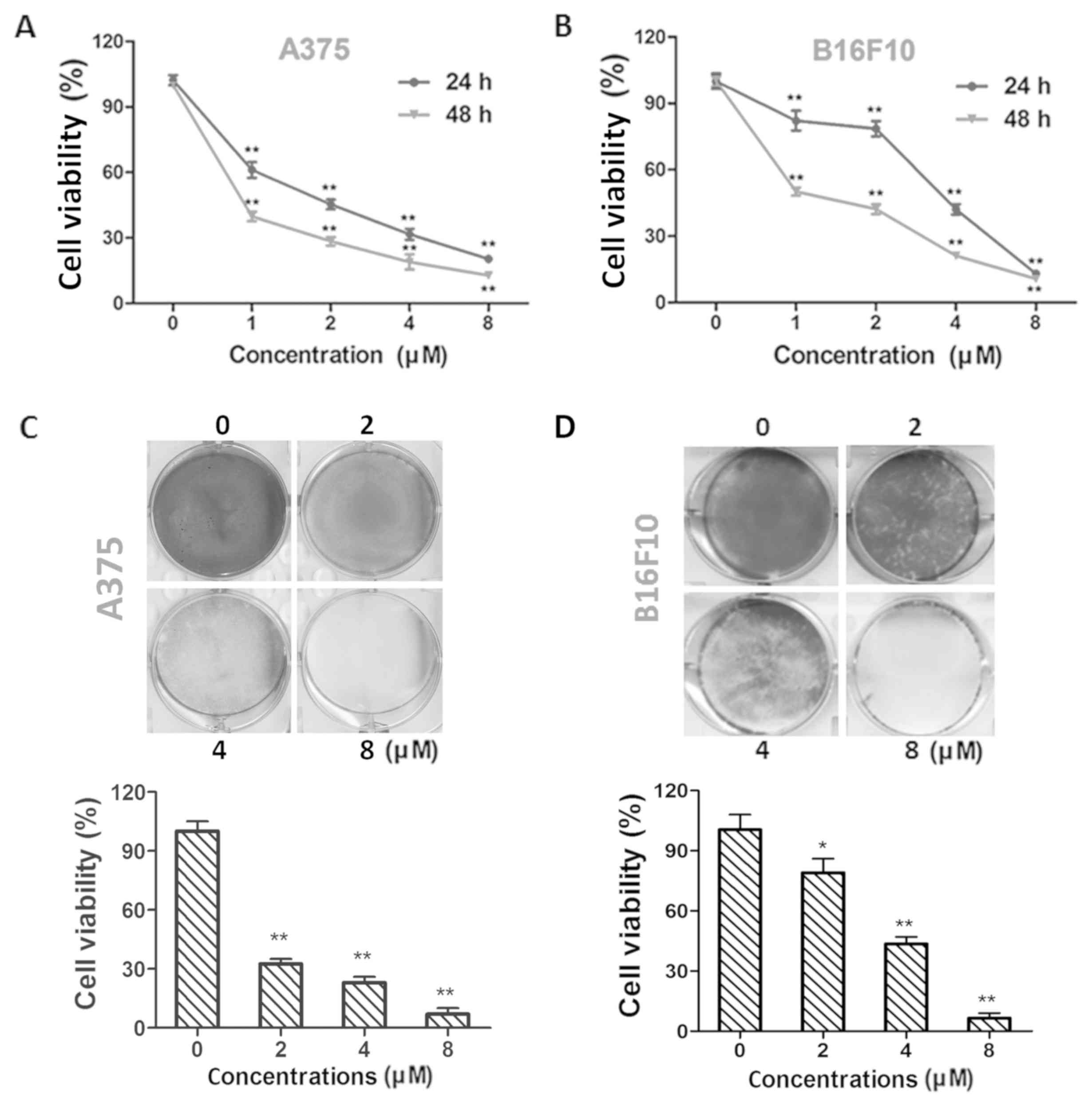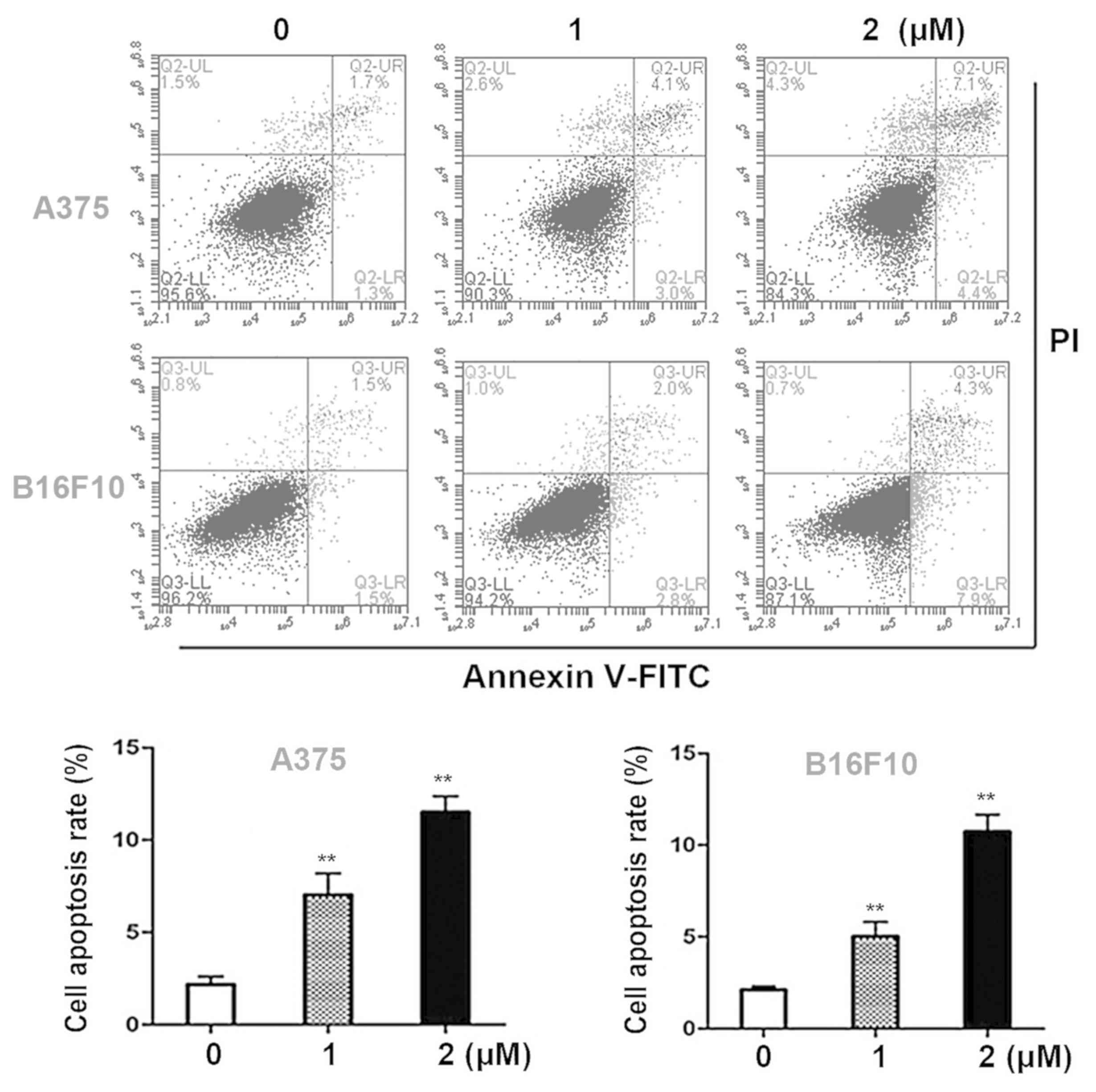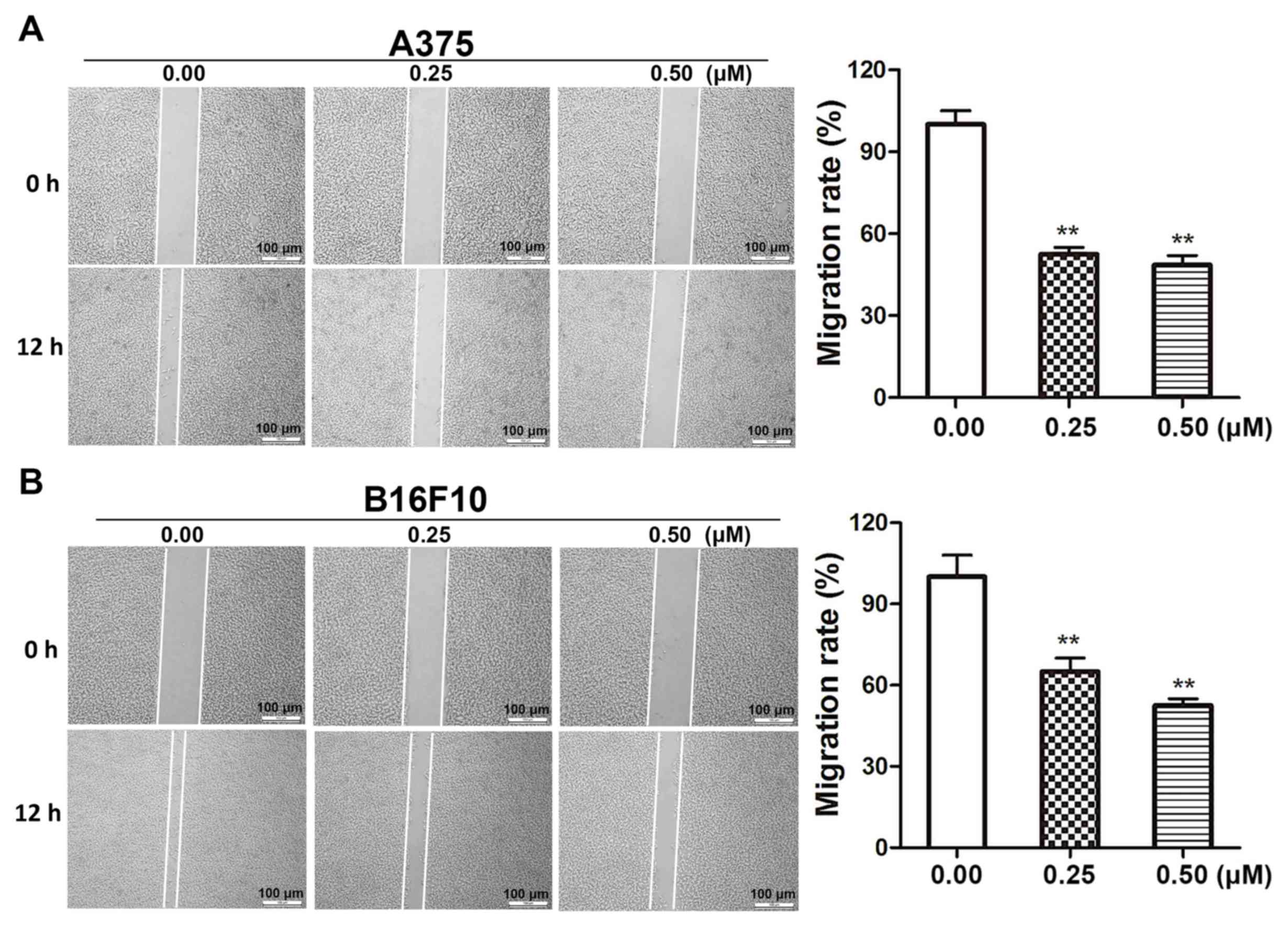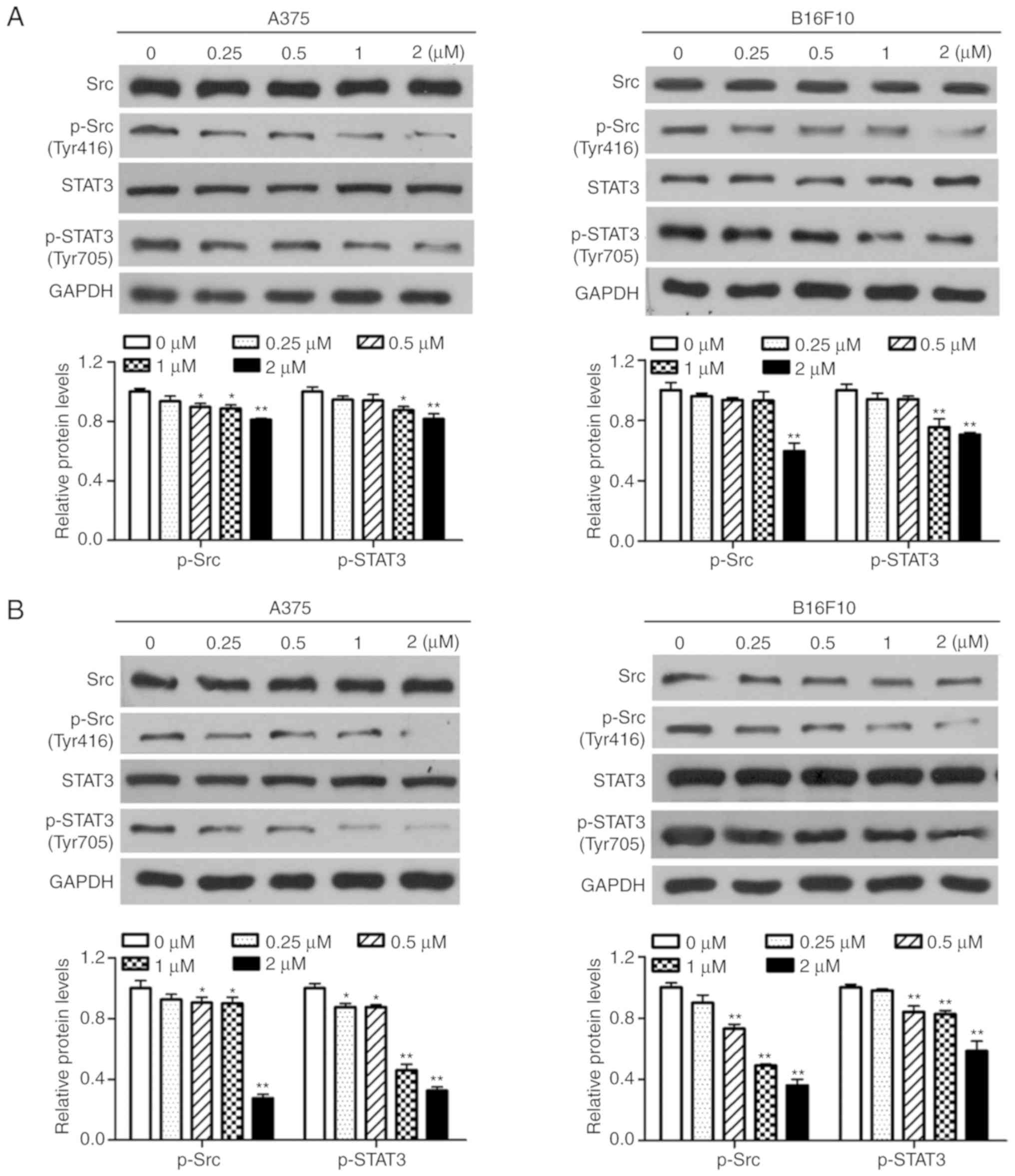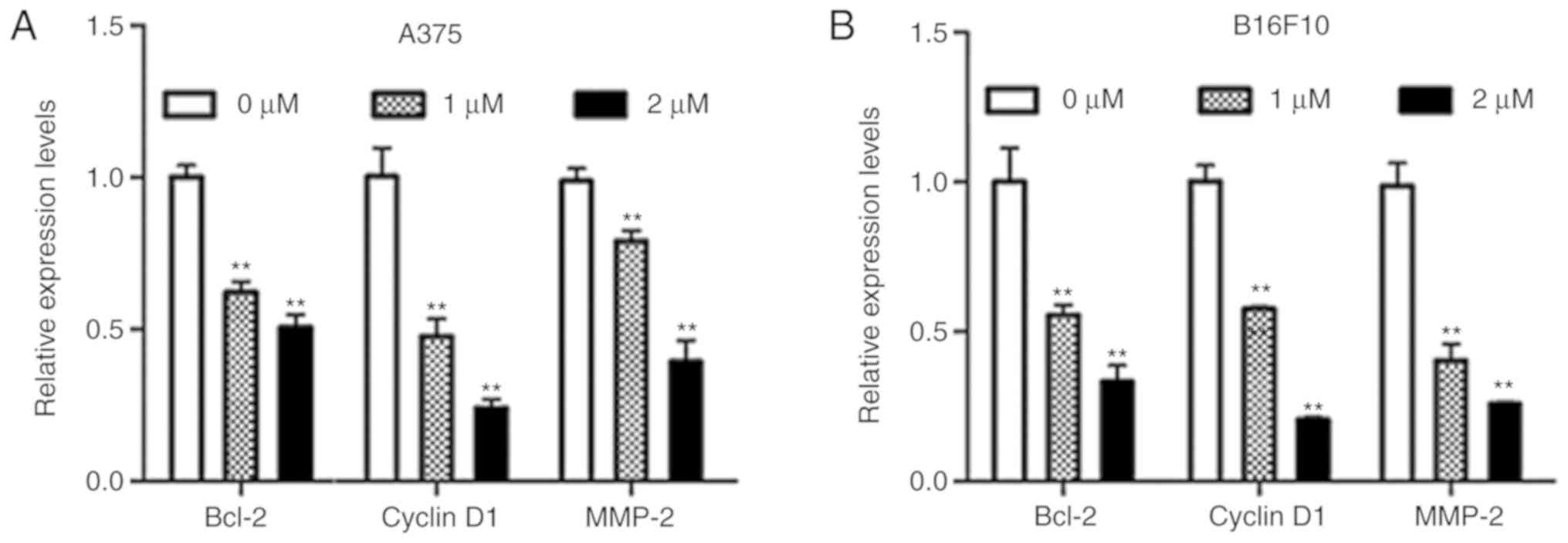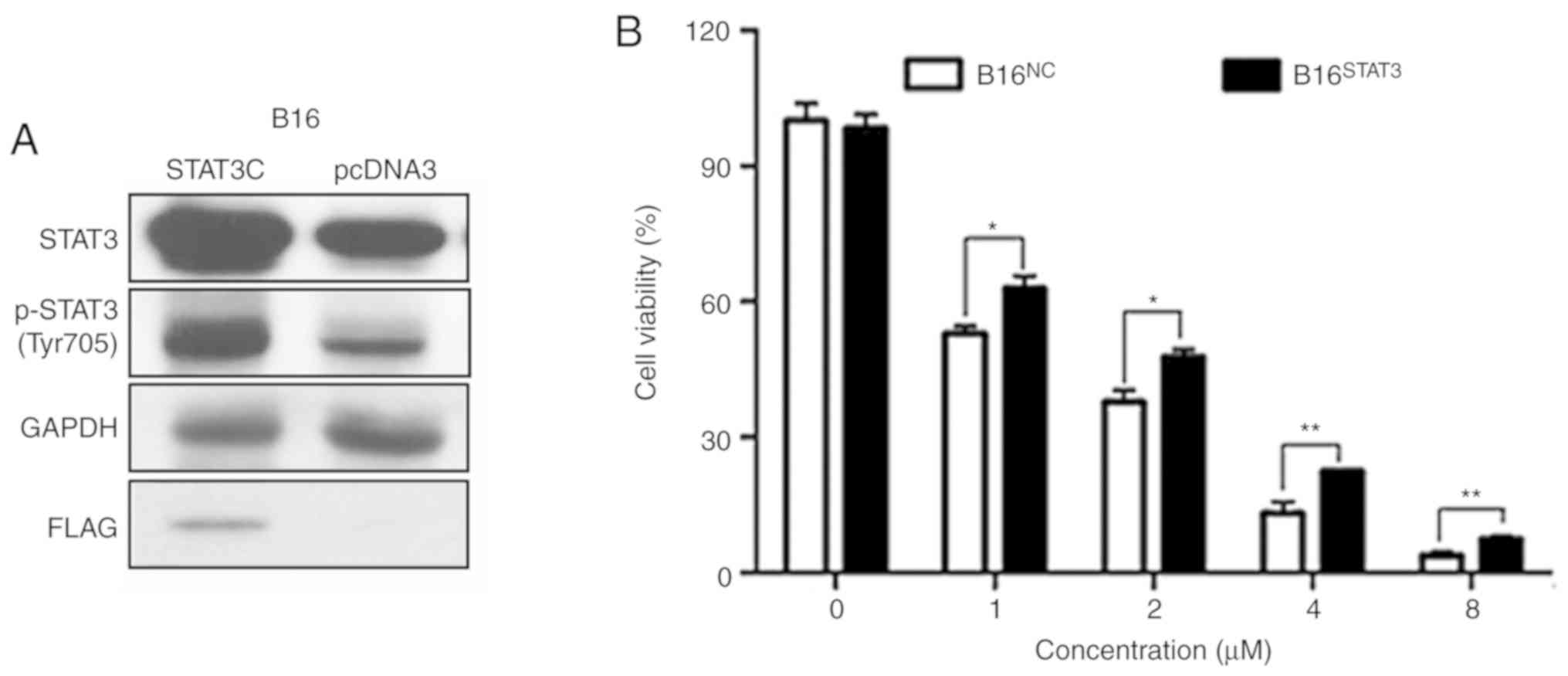|
1
|
Skin cancer facts & statistics 2019.
https://www.skincancer.org/skin-cancer-information/skin-cancer-facts/
|
|
2
|
Rogiers A, Boekhout A, Schwarze JK, Awada
G, Blank CU and Neyns B: Long-term survival, quality of life, and
psychosocial outcomes in advanced melanoma patients treated with
immune checkpoint inhibitors. J Oncol. 2019:52690622019. View Article : Google Scholar : PubMed/NCBI
|
|
3
|
Garbe C, Peris K, Hauschild A, Saiag P,
Middleton M, Spatz A, Grob JJ, Malvehy J, Newton-Bishop J,
Stratigos A, et al: Diagnosis and treatment of melanoma. European
consensus-based interdisciplinary guideline-update 2012. Eur J
Cancer. 48:2375–2390. 2012. View Article : Google Scholar : PubMed/NCBI
|
|
4
|
Palumbo G, Lorenzo GD, Ottaviano M and
Damiano V: The future of melanoma therapy: Developing new drugs and
improving the use of old ones. Future Oncol. 12:2531–2534. 2016.
View Article : Google Scholar : PubMed/NCBI
|
|
5
|
Kortylewski M, Jove R and Yu H: Targeting
STAT3 affects melanoma on multiple fronts. Cancer Metastasis Rev.
24:315–327. 2005. View Article : Google Scholar : PubMed/NCBI
|
|
6
|
Siveen KS, Sikka S, Surana R, Dai X, Zhang
J, Kumar AP, Tan BK, Sethi G and Bishayee A: Targeting the STAT3
signaling pathway in cancer: Role of synthetic and natural
inhibitors. Biochim Biophys Acta. 1845:136–154. 2014.PubMed/NCBI
|
|
7
|
Li T, Fu X, Tse AK, Guo H, Lee KW, Liu B,
Su T, Wang X and Yu Z: Inhibiting STAT3 signaling is involved in
the anti-melanoma effects of a herbal formula comprising Sophorae
Flos and Lonicerae Japonicae Flos. Sci Rep. 7:30972017. View Article : Google Scholar : PubMed/NCBI
|
|
8
|
Liu YX, Bai JX, Li T, Fu XQ, Guo H, Zhu
PL, Chan YC, Chou JY, Yin CL, Li JK, et al: A TCM formula
comprising Sophorae Flos and Lonicerae Japonicae Flos alters
compositions of immune cells and molecules of the STAT3 pathway in
melanoma microenvironment. Pharmacol Res. 142:115–126. 2019.
View Article : Google Scholar : PubMed/NCBI
|
|
9
|
Yu H, Pardoll D and Jove R: STATs in
cancer inflammation and immunity: A leading role for STAT3. Nat Rev
Cancer. 9:798–809. 2009. View
Article : Google Scholar : PubMed/NCBI
|
|
10
|
Yang L, Ren S, Xu F, Ma Z, Liu X and Wang
L: Recent advances in the pharmacological activities of dioscin.
Biomed Res Int. 2019:57636022019. View Article : Google Scholar : PubMed/NCBI
|
|
11
|
Xu LN, Wei YL and Peng JY: Advances in
study of dioscin-a natural product. Zhongguo Zhong Yao Za Zhi.
40:36–41. 2015.(In Chinese). PubMed/NCBI
|
|
12
|
Wei Y, Xu Y, Han X, Qi Y, Xu L, Xu Y, Yin
L, Sun H, Liu K and Peng J: Anti-cancer effects of dioscin on three
kinds of human lung cancer cell lines through inducing DNA damage
and activating mitochondrial signal pathway. Food Chem Toxicol.
59:118–128. 2013. View Article : Google Scholar : PubMed/NCBI
|
|
13
|
Kou Y, Ji L, Wang H, Wang W, Zheng H, Zou
J, Liu L, Qi X, Liu Z, Du B and Lu L: Connexin 43 upregulation by
dioscin inhibits melanoma progression via suppressing malignancy
and inducing M1 polarization. Int J Cancer. 141:1690–1703. 2017.
View Article : Google Scholar : PubMed/NCBI
|
|
14
|
Xiao J, Zhang G, Li B, Wu Y, Liu X, Tan Y
and Du B: Dioscin augments HSV-tk-mediated suicide gene therapy for
melanoma by promoting connexin-based intercellular communication.
Oncotarget. 8:798–807. 2017.PubMed/NCBI
|
|
15
|
Tao X, Sun X, Yin L, Han X, Xu L, Qi Y, Xu
Y, Li H, Lin Y, Liu K and Peng J: Dioscin ameliorates cerebral
ischemia/reperfusion injury through the downregulation of TLR4
signaling via HMGB-1 inhibition. Free Radic Biol Med. 84:103–115.
2015. View Article : Google Scholar : PubMed/NCBI
|
|
16
|
Tong Q, Qing Y, Wu Y, Hu X, Jiang L and Wu
X: Dioscin inhibits colon tumor growth and tumor angiogenesis
through regulating VEGFR2 and AKT/MAPK signaling pathways. Toxicol
Appl Pharmacol. 281:166–173. 2014. View Article : Google Scholar : PubMed/NCBI
|
|
17
|
Wu J, Chen Q, Liu W and Lin JM: A simple
and versatile microfluidic cell density gradient generator for
quantum dot cytotoxicity assay. Lab Chip. 13:1948–1954. 2013.
View Article : Google Scholar : PubMed/NCBI
|
|
18
|
Su T, Bai JX, Chen YJ, Wang XN, Fu XQ, Li
T, Guo H, Zhu PL, Wang Y and Yu ZL: An ethanolic extract of
Ampelopsis Radix exerts anti-colorectal cancer effects and potently
inhibits STAT3 signaling in vitro. Front Pharmacol. 8:2272017.
View Article : Google Scholar : PubMed/NCBI
|
|
19
|
Cheng BC, Ma XQ, Kwan HY, Tse KW, Cao HH,
Su T, Shu X, Wu ZZ and Yu ZL: A herbal formula consisting of rosae
multiflorae fructus and Lonicerae Japonicae Flos inhibits
inflammatory mediators in LPS-stimulated RAW 264.7 macrophages. J
Ethnopharmacol. 153:922–927. 2014. View Article : Google Scholar : PubMed/NCBI
|
|
20
|
Eriksson E, Milenova I, Wenthe J, Dimberg
A, Moreno R, Ullenhag G, Alemany R and Loskog A: Abstract 3662:
Activation of CD40 while inhibiting IL6/STAT3 using oncolytic
viruses induces mature DCs with high cytokine production but blocks
PDL1 expression. Cancer Res. 77:36622017.
|
|
21
|
Schmittgen TD and Livak KJ: Analyzing
real-time PCR data by the comparative C(T) method. Nat Protoc.
3:1101–1108. 2008. View Article : Google Scholar : PubMed/NCBI
|
|
22
|
Nishina A, Ebina K, Ukiya M, Fukatsu M,
Koketsu M, Ninomiya M, Sato D and Kimura H: Dioscin derived from
Solanum melongena L.‘Usukawamarunasu’ attenuates α-MSH-Induced
melanogenesis in B16 murine melanoma cells via downregulation of
phospho-CREB and MITF. J Food Sci. 80:H2354–H2359. 2015. View Article : Google Scholar : PubMed/NCBI
|
|
23
|
Jing N and Tweardy DJ: Targeting Stat3 in
cancer therapy. Anticancer Drugs. 16:601–607. 2005. View Article : Google Scholar : PubMed/NCBI
|
|
24
|
Xing E, Guo Y, Feng G, Song H, An G, Zhao
X and Wang M: Effects of dioscin on T helper 17 and regulatory
T-cell subsets in chicken collagen type II-induced arthritis mice.
J Chin Med Assoc. 82:202–208. 2019. View Article : Google Scholar : PubMed/NCBI
|
|
25
|
Zhao T, Jia H, Cheng Q, Xiao Y, Li M, Ren
W, Li C, Feng Y, Feng Z, Wang H and Zheng J: Nifuroxazide prompts
antitumor immune response of TCL-loaded DC in mice with
orthotopically- implanted hepatocarcinoma. Oncol Rep. 37:3405–3414.
2017. View Article : Google Scholar : PubMed/NCBI
|
|
26
|
Groner B, Lucks P and Borghouts C: The
function of Stat3 in tumor cells and their microenvironment. Semin
Cell Dev Biol. 19:341–350. 2008. View Article : Google Scholar : PubMed/NCBI
|















